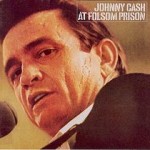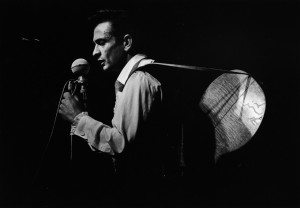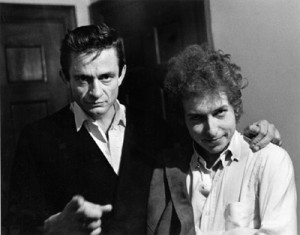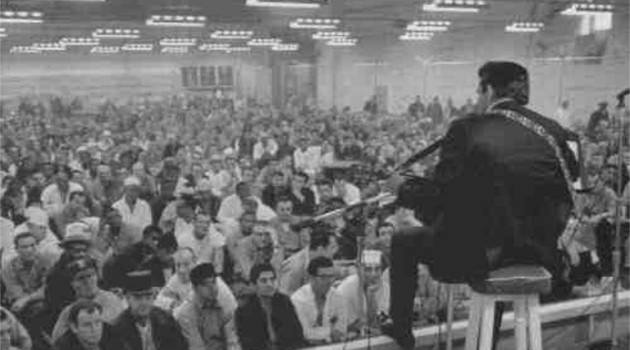Written by Elizabeth Stack. 21 October 2014.
 In May of 1968, Johnny Cash released his live album, At Folsom Prison. It would go on to be the defining album of his career. He was a man shrouded in myths, and with At Folsom Prison he continued the mystery. The recording’s dark themes of murder, life as an outlaw, and redemption helped create the legendary figure of The Man in Black. He managed to combine wry humor, his signature somberness, and somehow a vitality not previously heard from him, all at once. His languishing career was revitalized, and the album is now often listed among one of the most influential in country music.
In May of 1968, Johnny Cash released his live album, At Folsom Prison. It would go on to be the defining album of his career. He was a man shrouded in myths, and with At Folsom Prison he continued the mystery. The recording’s dark themes of murder, life as an outlaw, and redemption helped create the legendary figure of The Man in Black. He managed to combine wry humor, his signature somberness, and somehow a vitality not previously heard from him, all at once. His languishing career was revitalized, and the album is now often listed among one of the most influential in country music.
The roots of At Folsom Prison reach back to Cash’s time in the army. While overseas in Germany he first became fascinated by the violence of prison life after viewing the B-grade movie Inside the Walls of Folsom Prison. It was there that he wrote some of his first professional recordings such as the hits, “I Walk the Line”, and the namesake track, “Folsom Prison Blues,” which were both successful in the late 1950’s before appearing again on At Folsom Prison.
Cash held a deep sympathy for prisoners and recycled “Folsom Prison Blues” in At Folsom Prison, because he wanted to perform songs that they could identify with, that as the concert’s announcer Hugh Cherry said, “Had the feel of them,” and to perhaps provide a kind of comfort. Many of the songs were from a prisoner’s point of view, and he even included a song written by one of the inmates present in the audience, “Greystone Chapel,” by Glen Shirley. Throughout his career Cash continued to reach the everyday working class, the disenchanted, those on the fringe of society, by adopting the prisoner persona.
After signing with Sun Records in 1955, Cash had begun to gain notoriety, but felt restricted by his contract, and moved to Columbia Records in 1958. That same year he proposed a live album at a prison for the first time. Along with a few other acts, he had already been performing free concerts for prisoners, and would continue to do so throughout his career. Columbia executives, however, shut him down, stating a prison album would be career suicide. They thought audiences wouldn’t want to be reminded of the unsavory characters ousted from society, much less support them the way Johnny did. Ironically, it would be the thing to bring his career back to life.
The record may have never been made if not for personnel changes at Columbia, which placed Bob Dylan’s experimental producer Bob Johnston in charge of Cash’s recordings. Finally, someone with the willingness and enthusiasm to make a live prison album happen was telling Johnny yes.
Along with his band The Tennessee Three, his wife June Carter, The Statler Brothers, and Carl Perkins of “Blue Suede Shoes” fame, Johnny Cash arrived at Folsom Prison on January 13, 1968. They gave two performances that day, but the majority of the album’s tracks were culled from the first. By the second time around the performers were tired out, and unable to deliver the same magic energy.
 At Folsom Prison was released at a key time for a few reasons. As he had risen to fame, Cash also picked up a dangerous drug habit. Throughout the early to mid 60’s, Cash’s use of amphetamines was at its peak, yet he continued to be creatively productive and crank out hits (Streissguth 33). Ultimately though, he became erratic and unreliable; eventually no one wanted to work with him. Between his failing health and nervous instability, he could no longer keep up and his career suffered a substantial downturn. Cash became severely depressed, nearly ending his life, before realizing he wasn’t ready to throw it all away.
At Folsom Prison was released at a key time for a few reasons. As he had risen to fame, Cash also picked up a dangerous drug habit. Throughout the early to mid 60’s, Cash’s use of amphetamines was at its peak, yet he continued to be creatively productive and crank out hits (Streissguth 33). Ultimately though, he became erratic and unreliable; eventually no one wanted to work with him. Between his failing health and nervous instability, he could no longer keep up and his career suffered a substantial downturn. Cash became severely depressed, nearly ending his life, before realizing he wasn’t ready to throw it all away.
After cleaning himself up, Cash needed a comeback, and At Folsom Prison, a project that had been tabled for a decade,was the spark that reignited him. Though he never served prison time, the songs of At Folsom Prison reflect the journey of Cash’s sorrow, his struggle to live a good life, and his eventual redemption. His marked past and quiet defiance made him an inspiration for the outlaw movement, and further reinforced his credibility as one of the characters he portrayed in his songs.
Tragically, shortly after the release of At Folsom Prison both Robert Kennedy, and Martin Luther King Jr. were assassinated, which made the lines, “I killed a man in Reno/ Just to watch him die,” in “Folsom Prison Blues,” both highly relevant and controversial. Many radio stations would not play the song unless those lines were edited out. With both the Vietnam War and the Civil Rights Movement in full swing, the entire country was in the process of restructuring, both politically and socially.
While much of the music being released was considered experimental, Cash, better than anyone else, was able to capture the mood of unrest. The album is centered on those at the fringe of society, which connected with audiences who were now questioning the societal norms. Many people were being jailed for things such as trying to avoid the draft and civil disobedience, which blurred the perception of what a criminal was. Suddenly, they became sympathetic figures, symbols of justified rebellion. Cash realized that his listeners were also angst filled souls, eager to distance themselves from the mainstream, and knew they would be able to identify with the album. Released at any other time, At Folsom Prison may not have held the same significance to his audience, or the social relevance.
In part because of the social issues occurring at the time, and partly because they had never believed in the album to begin with, Columbia records put minimal effort into the promotion of At Folsom Prison. The attention of audiences is fickle, and for many artists a comeback can be difficult to execute even with the support of their label. Therefore, it was surprising that by October of 1968, the album was certified gold.
 Luckily, Cash had built up a large following in the folk community by publicly supporting artists such as Bob Dylan, and in 1964 became one of the few country artists to be invited to play at the Newport Folk Festival.It was there that Dylan and Cash began a friendship, and soon after started recording together. Though strung out on drugs at the time, Cash gave a rousing performance and solidified his place as a country/folk crossover artist (Streissguth 29). Many of his songs, though mostly country in sound, also capture the folk free spirit, and nationalism that appealed to folk fans. In the months surrounding At Folsom Prison’s release, it was this community who built up substantial buzz for the album, contributing to its success.
Luckily, Cash had built up a large following in the folk community by publicly supporting artists such as Bob Dylan, and in 1964 became one of the few country artists to be invited to play at the Newport Folk Festival.It was there that Dylan and Cash began a friendship, and soon after started recording together. Though strung out on drugs at the time, Cash gave a rousing performance and solidified his place as a country/folk crossover artist (Streissguth 29). Many of his songs, though mostly country in sound, also capture the folk free spirit, and nationalism that appealed to folk fans. In the months surrounding At Folsom Prison’s release, it was this community who built up substantial buzz for the album, contributing to its success.
At Folsom Prison gave a setting to the songs of quiet rebellion Cash had sung throughout his career. When listening to the tracks, and hearing the prisoners in the background, it almost seems Cash could start an uprising if he chose to. Every track buzzes with a raw and almost aggressive energy. The end result is an album steeped in myth yet gritty and realistic. While listening to the signature thump thump of the bass in “Folsom Prison Blues” one is instilled with the deep sense of monotony and longing prison life entails.
In his songs Cash so perfectly captures the spirit of a prisoner, you start to get the feeling he just might have shot someone in Reno. If anything, The Man in Black knew what it meant to be a prisoner of his own mind, body, and spirit, and he wore his stripes like a badge of honor (Erlewine).
Side 1:
1. “Folsom Prison Blues” (J. Cash)
2. “Dark as a Dungeon” (M. Travis)
3. “I Still Miss Someone” (J. Cash, R Jr.)
4. “Cocaine Blues” (T.J. Arnall)
5. “25 Minutes to Go” (S. Silverstein)
6. “Orange Blossom Special” (E.T. Rouse)
7. “The Long Black Veil” (M. Wilkin, D. Dill)
Side 2:
1. “Send a Picture of Mother”(J. Cash)
2. “The Wall” (H. Howard)
3. “Dirty Old Egg-Suckin’ Dog” (J.H. Clement)
4. “Flushed From the Bathroom of Your Heart” (J.H.Clement)
5. “Jackson” (with June Carter) Billy Edd Wheeler, Jerry Leiber (as Gaby Rodgers)
6. “Give My Love to Rose” (J. Carter, J. Cash)
7. “I Got Stripes” (J. Cash, C. Williams)
8. “Green, Green Grass of Home” (C. Putman)
9. “Greystone Chapel” (G. Sherley)
Works Cited
Cash, Johnny, June Carter Cash, and Carl Perkins. Johnny Cash at Folsom Prison. Perf. Marshall Grant, W. S. Holland, and Luther Perkins. Columbia/Legacy, 1999. CD.
Erlewine, Stephen T. “At Folsom Prison – Johnny Cash | Songs, Reviews, Credits, Awards | AllMusic.” AllMusic. N.p., n.d. Web. 14 Oct. 2014.
Streissguth, Michael. Johnny Cash at Folsom Prison: The Making of a Masterpiece. Cambridge, MA: Da Capo, 2004. Print.

